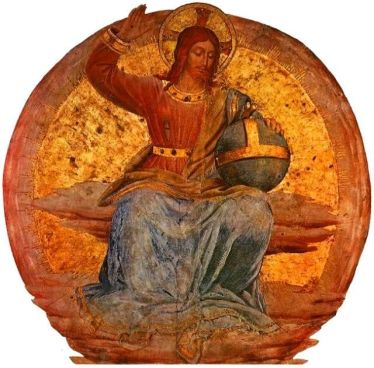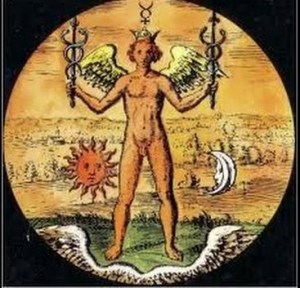What, you may ask, does the Philosophy of the Renaissance Neo-Platonist have to do with the Winter Solstice and Christmas? The key is in the image and nature of the Sun itself. Astrologically, the Sun is King and the Moon is Queen. At the time of the Winter Solstice, we have the longest night, to be followed three days later by the ‘return’ of the Sun, as he makes his way Northward in that hemisphere, bringing us ever longer days, until the advent of the Summer Solstice, just as the Sun enters the Lunar sign of Cancer..
It has become very popular to conflate all Solar Deities, to carelessly list their attributes, then to take a rather large leap of logic and dogmatically state that they are mere myths and that therefore the Christian version must be a fraud – a cheap knock off — devised to enthral the foolish masses. . It is said that the myths are really just the same story, based on astronomy and recycled to suit the zeitgeist. However, that is to miss the point entirely.
From the beginning of Christianity, it was received among others by Hellenized Jews.The Christ is Logos. Christian Neoplatonists were quite aware of a plethora of Solar Myths, but remained undeterred in affording Pre- Eminence to Christianity The story of the Winter Solstice and Yule can be told from many different cultural perspectives. Here we have what might be called a Neoplatonic Christmas tale. It is among the most significant of all interpretations.
In his earlier years, Marsilio Ficino had an uneasy relationship with astrology, but by the time he wrote his treatise “On the Sun.” he had managed to wed Platonism and Hermetica with Christianity. He had become more completely syncretic. He seems at this point to be first and foremost a Neo-Platonists, just as many of the best known Christian apologists had been. from before Clement of Alexandria to the Late Renaissance. The newly translated Hermetica was in harmony with the traditions that Ficino was already at home with. He has now translated the Works if Plato, Hermes and Plotinus. Plotinus is regarded as perhaps the most brilliant of the Neoplatonusrs. Ficino was also a priest, so he was in a particularly advantageous position to talk about the Sun from a Christian Neoplatonic point of view that was very much in harmony with his form of Astrology.
The newly translated Hermetica was in harmony with the traditions that Ficino was already at home with. He has now translated the Works if Plato, Hermes and Plotinus. Plotinus is regarded as perhaps the most brilliant of the Neoplatonusrs. Ficino was also a priest, so he was in a particularly advantageous position to talk about the Sun from a Christian Neoplatonic point of view that was very much in harmony with his form of Astrology.
Ficino writes: “According to the Platonists there are three principles: the good itself, the divine intellect and the world soul. Only light clearly contains all of them in itself. It reveals the good itself, since while it surpasses wonderfully all things, it also spreads itself through all things, and recalls them to sublime planes at the same time with its miraculously preserved excellence and purity.”
These are of course divine attributes and the image of the Sun becomes a symbol of the Soul, made in the Image of God. We are no longer generally accustomed to experiencing the natural cycles of the year as divine, in these days marked by conspicuous consumption, ignorance of the skies and a contempt for virtually any form of authentic philosophy. We have mostly abandoned true wonder for fancy and Truth for distraction.
The Sun is studied by scientists, not Christian Neoplatonists. For scientists, the very idea of Soul is synonymous with delusion and naivete. Yet is has recently been discovered that the Sun has what appears to be a kind of heartbeat. Who could reasonably deny that the Sun is alive? Who could fault early humans with worshipping the Sun itself, the bringer of light, warmth and without which there can be no life at all.
The three monotheistic religions are said to be under the following luminaries and planets: Judaism is Saturn, Islam is Venus and Christianity is the Sun. The days held to be holy by each is reflective of this. The Jewish

Sol Invictus
Sabbath is Saturn’s Day; the Islamic is Friday and the Christian is Sunday. In fact, any Solar religion, such as Zoroastrianism or Mithraism would take on the same association. Hinduism is under Jupiter. All the planets can be considered as children of the Sun King. Each of us is a child of the Sun, physically and spiritually.
Marsilio Ficino writes in Chapter Six of the Book of the Sun:
“All [traditions] locate the Sun, like a lord, in the center of the world, although by different arguments. The Chaldeans, for instance, [place it] in the middle of the planets, the Egyptians actually [place it] between two quintuple worlds, as surely the five planets are above it, and below it are the Moon and the four elements…. [Some] actually postulate the disposition of the Sun in this way, such that Saturn, Jupiter and Mars are elevated above him, while on the other hand, Venus, Mercury and the Moon are below the Sun. which proceeds as a king, taking the middle way. Going by other ways, weaker ones avoid him.”
Plato uses the metaphor of the Sun repeatedly. Perhaps the best known is in the Allegory of the Cave. Slaves are chained before a wall watching a shadow play they assume to be real. When one manages to leave the darkness, he is overwhelmed by the brightness of the Sun. The Sun is a metaphor for truth or even God Himself. The Sun makes life possible by enabling a world of light. On a literal level, without the light of the Sun, we would be in darkness. It could hardly be more primal.
The Sun is a metaphor for truth or even God Himself. The Sun makes life possible while enabling by enabling a world of light. On a literal level, without the light of the Sun, we would be in darkness. It could hardly be more primal. James writes: “Every good gift and every perfect gift is from above, and cometh down from the Father of lights, with whom is no variableness, neither shadow of turning;” (James 1:17)
Following the lead of Zoroastrian priests, Ficino is often seen in red gowns. This association of fire and the colour red lives on in a parallel tradition wherein Santa Claus dons read cloths and enters homes by way of the fireplace. It could hardly be more solar and it’s quite natural that Christians adopted this time of year to celebrate the birth of Christ. I should think that by now most Christians are aware that this isn’t necessarily the birthday of Jesus. Most are also aware of other traditions that celebrate Solar deities, many of whom preceded historical Christianity. That doesn’t change the fact that this time of year is sacred
I should;d think that by now most Christians are aware that this isn’t necessarily the birthday of Jesus. Most are also aware of other traditions that celebrate Solar deities, many of whom preceded historical Christianity, while some came after. That doesn’t change the fact that this time of year is sacred to a wide range of traditions, each understanding the deity in their own way.
At the time of the Winter Solstice, we have the longest night as well as a promise of the resurgence of the light force. In mystical Christianity, it is perfectly understood that what is above, is below. That is, after all, the essence of John’s Gospel and in many other parts of the New Testament.
We live in times where if something isn’t literally true, it must be false. This has been adopted by what I call “scientific fundamentalists” such as Richard Dawkins. I have great respect for science, but when there is a complete denial of spiritual vision I have to question its veracity.



Reblogged this on Jewish and Christian News.